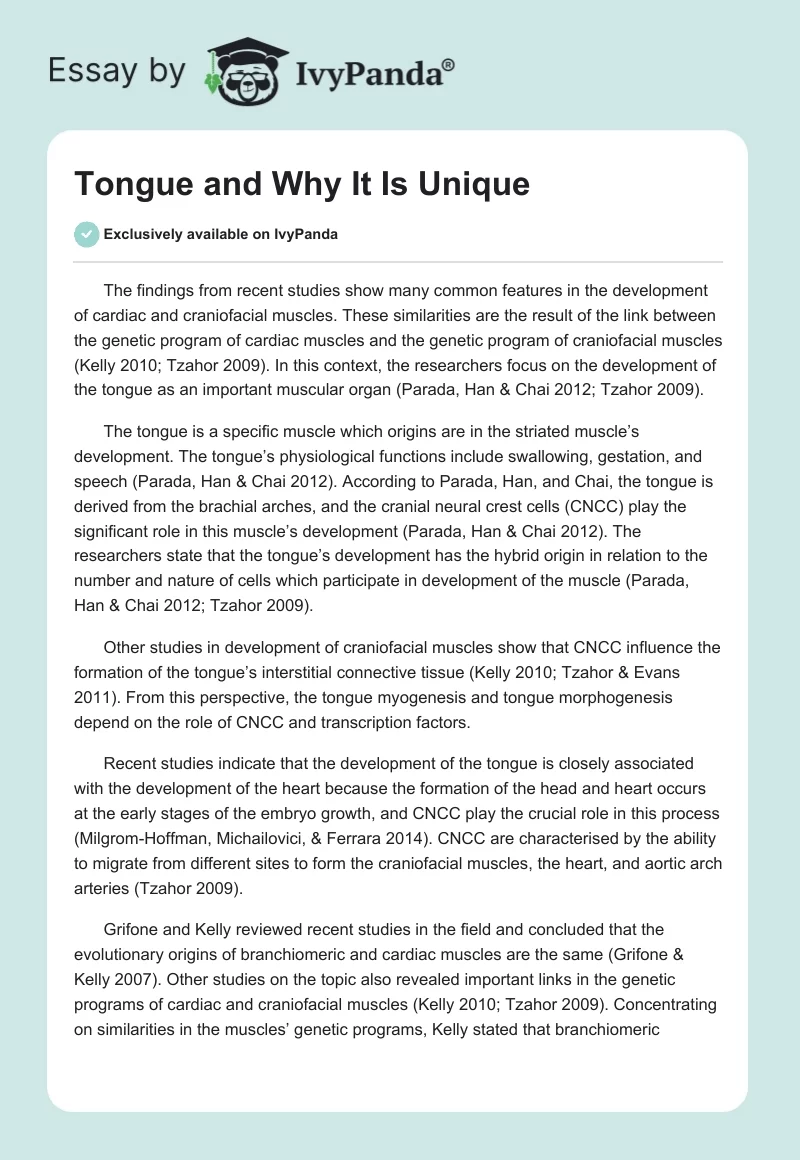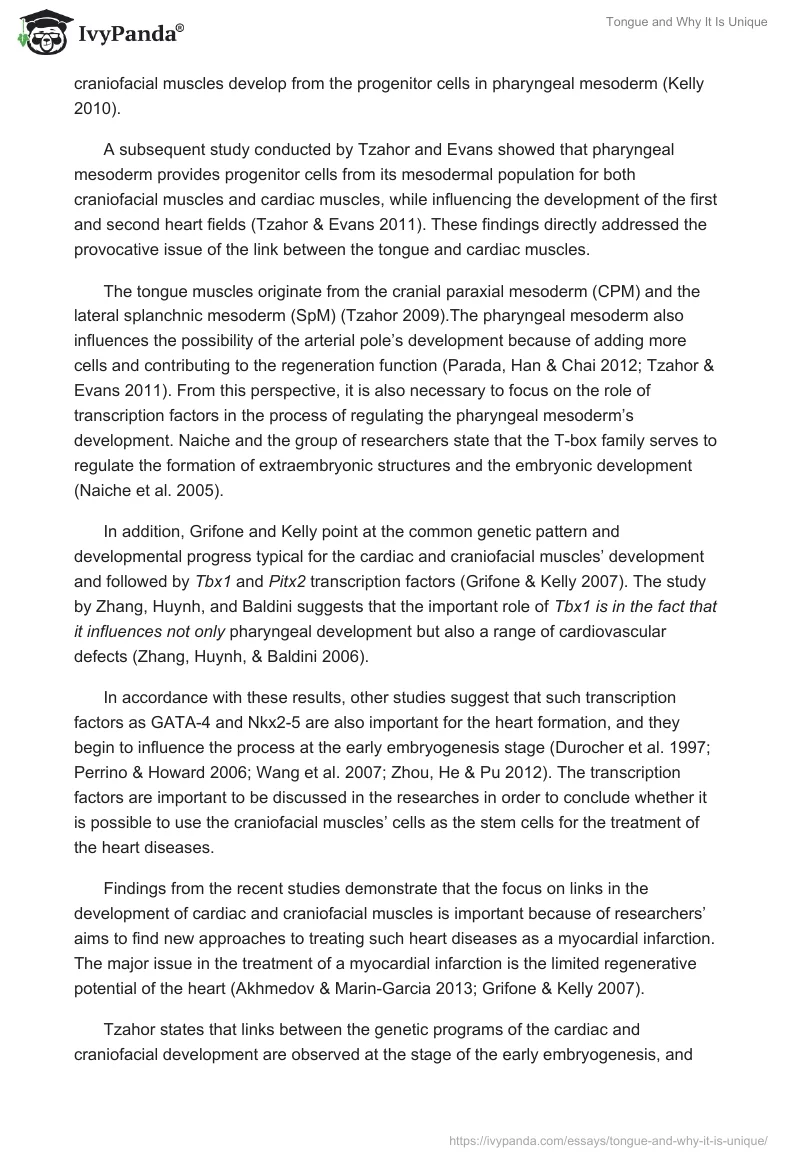The findings from recent studies show many common features in the development of cardiac and craniofacial muscles. These similarities are the result of the link between the genetic program of cardiac muscles and the genetic program of craniofacial muscles (Kelly 2010; Tzahor 2009). In this context, the researchers focus on the development of the tongue as an important muscular organ (Parada, Han & Chai 2012; Tzahor 2009).
The tongue is a specific muscle which origins are in the striated muscle’s development. The tongue’s physiological functions include swallowing, gestation, and speech (Parada, Han & Chai 2012). According to Parada, Han, and Chai, the tongue is derived from the brachial arches, and the cranial neural crest cells (CNCC) play the significant role in this muscle’s development (Parada, Han & Chai 2012). The researchers state that the tongue’s development has the hybrid origin in relation to the number and nature of cells which participate in development of the muscle (Parada, Han & Chai 2012; Tzahor 2009).
Other studies in development of craniofacial muscles show that CNCC influence the formation of the tongue’s interstitial connective tissue (Kelly 2010; Tzahor & Evans 2011). From this perspective, the tongue myogenesis and tongue morphogenesis depend on the role of CNCC and transcription factors.
Recent studies indicate that the development of the tongue is closely associated with the development of the heart because the formation of the head and heart occurs at the early stages of the embryo growth, and CNCC play the crucial role in this process (Milgrom-Hoffman, Michailovici, & Ferrara 2014). CNCC are characterised by the ability to migrate from different sites to form the craniofacial muscles, the heart, and aortic arch arteries (Tzahor 2009).
Grifone and Kelly reviewed recent studies in the field and concluded that the evolutionary origins of branchiomeric and cardiac muscles are the same (Grifone & Kelly 2007). Other studies on the topic also revealed important links in the genetic programs of cardiac and craniofacial muscles (Kelly 2010; Tzahor 2009). Concentrating on similarities in the muscles’ genetic programs, Kelly stated that branchiomeric craniofacial muscles develop from the progenitor cells in pharyngeal mesoderm (Kelly 2010).
A subsequent study conducted by Tzahor and Evans showed that pharyngeal mesoderm provides progenitor cells from its mesodermal population for both craniofacial muscles and cardiac muscles, while influencing the development of the first and second heart fields (Tzahor & Evans 2011). These findings directly addressed the provocative issue of the link between the tongue and cardiac muscles.
The tongue muscles originate from the cranial paraxial mesoderm (CPM) and the lateral splanchnic mesoderm (SpM) (Tzahor 2009).The pharyngeal mesoderm also influences the possibility of the arterial pole’s development because of adding more cells and contributing to the regeneration function (Parada, Han & Chai 2012; Tzahor & Evans 2011). From this perspective, it is also necessary to focus on the role of transcription factors in the process of regulating the pharyngeal mesoderm’s development. Naiche and the group of researchers state that the T-box family serves to regulate the formation of extraembryonic structures and the embryonic development (Naiche et al. 2005).
In addition, Grifone and Kelly point at the common genetic pattern and developmental progress typical for the cardiac and craniofacial muscles’ development and followed by Tbx1 and Pitx2 transcription factors (Grifone & Kelly 2007). The study by Zhang, Huynh, and Baldini suggests that the important role of Tbx1 is in the fact that it influences not only pharyngeal development but also a range of cardiovascular defects (Zhang, Huynh, & Baldini 2006).
In accordance with these results, other studies suggest that such transcription factors as GATA-4 and Nkx2-5 are also important for the heart formation, and they begin to influence the process at the early embryogenesis stage (Durocher et al. 1997; Perrino & Howard 2006; Wang et al. 2007; Zhou, He & Pu 2012). The transcription factors are important to be discussed in the researches in order to conclude whether it is possible to use the craniofacial muscles’ cells as the stem cells for the treatment of the heart diseases.
Findings from the recent studies demonstrate that the focus on links in the development of cardiac and craniofacial muscles is important because of researchers’ aims to find new approaches to treating such heart diseases as a myocardial infarction. The major issue in the treatment of a myocardial infarction is the limited regenerative potential of the heart (Akhmedov & Marin-Garcia 2013; Grifone & Kelly 2007).
Tzahor states that links between the genetic programs of the cardiac and craniofacial development are observed at the stage of the early embryogenesis, and this feature can influence the whole vision of the link between the head, tongue, and heart at the cell level (Tzahor 2009). In addition, Akhmedov and Marin-Garcia argue that heart diseases are the complex problem because the heart is characterised by the limited regenerative potential, and the widespread character of such problems as a myocardial infarction often leads to the increased mortality (Akhmedov & Marin-Garcia 2013).
Today, physicians are focused on practising the heart transplantation and implantation, but researchers explore a range of alternative strategies (Akhmedov & Marin-Garcia 2013; Kelly 2010). In this case, the main questions revealed in the studies are the possibility to use tongue cells for heart treatment because of the similar genetic programs.
Reference List
Akhmedov, AT & Marin-Garcia, J 2013, ‘Myocardial regeneration of the failing heart’, Heart Failure Reviews, vol. 18, no. 6, pp. 815-33.
Durocher, D, Charron, F, Warren, R, Schwartz, RJ & Nemer, M 1997, ‘The Cardiac Transcription factors Nkx2.5 and GATA4 are mutual cofactors’, The EMBO Journal, vol. 16, no.18, pp. 5687-96.
Grifone, R & Kelly, RG 2007, ‘Heartening news for head muscle development’, Trends in Genetics, vol. 23, no. 8, pp. 365-9.
Kelly, RG 2010, ‘Core issues in craniofacial myogenesis’, Experimental Cell Research, vol. 316, no. 18, pp. 3034-41.
Milgrom-Hoffman, M, Michailovici, I & Ferrara, N 2014, ‘Endothelial cells regulate neural crest and second heart field morphogenesis’, Biology Open, vol. 3, no. 8, pp. 679–688.
Naiche, LA, Zachary, H, Kelly, RG & Papaioannou, VE 2005, ‘T-Box Genes in Vertebrate Development’, Annual Review Genetics, vol. 39, no. 1, pp. 219-239.
Parada, C, Han, D & Chai, Y 2012, ‘Molecular and Cellular Regulatory Mechanisms of Tongue Myogenesis’, JDR, vol. 91, no. 6, pp. 528–535.
Perrino, C, & Howard, A 2006, ‘GATA4 and the two sides of gene expression reprogramming’, Circulation Research, vol. 98, no. 1, pp. 837-845.
Tzahor, E 2009, ‘Heart and craniofacial muscle development: a new developmental theme of distinct myogenic fields’, Developmental Biology, vol. 327, no. 2, pp. 273-279.
Tzahor, E & Evans, SM 2011, ‘Pharyngeal mesoderm development during embryogenesis: implications for both heart and head myogenesis’, Cardiovascular Research, vol. 91, no. 2, pp. 196-202.
Wang, Y, Morishima, M, Zheng, M, Uchino, T, Mannen, K, Takahashi, A, Nakaya, Y, Komuro, I & Ono, K 2007, ‘Transcription factors Csx/Nkx2.5 and GATA4 distinctly regulate expression of Ca2+ channels in neonatal rat heart’, Journal of Molecular and Cellular Cardiology, vol. 42, no. 6, pp. 1045-53.
Zhang, Z, Huynh, T & Baldini, A 2006, ‘Mesodermal expression of Tbx1 is necessary and sufficient for pharyngeal arch and cardiac outflow tract development’, Development, vol. 133, no. 18, pp. 3587-95.
Zhou, P, He, A & Pu, WT 2012, ‘Regulation of GATA4 transcriptional activity in cardiovascular development and disease’, Current topics in developmental biology, vol. 100, no. 1, pp. 143-69.


